|
TennisOne Lessons

The Gambill vs Agassi Backhand

Jim McLennan, Senior Editor, TennisONE
Click here to see
animation of Gambill backhand.
Click
here to see animation of Agassi backhand.
At the Newsweek Championship at Indian Wells Jan-Michael Gambill defeated
Andre Agassi in a close three set match in the quarter-finals. Gambill went
on to lose to Marcelo Rios in the semis, but ESPN announcers Cliff Drysdale
and Patrick McEnroe were already touting Gambill, blessed with Hollywood
good looks and two-handed shots from both sides, as the "future of
American tennis." That's hyping the career of this 20 year old who
has spent the last few years playing on the Challenger circuit. But I saw
Gambill play in the Sybase Open in San Jose, where he lost to Agassi (but
won more games than anyone else), and I can testify that Gambill is the
real thing.
A whole lot more will be written about Gambill in the coming months.
But since we just covered the Agassi backhand (click here to see that lesson),
I thought it would be interesting and instructive to compare Agassi's backhand
with Gambill's.
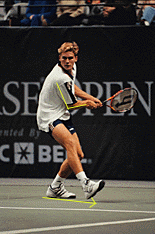 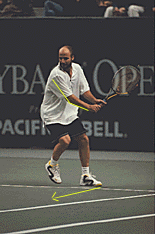 Note
the differences between the Gambill and Agassi backhands looking from the
feet up. Gambill's stance is more closed than Agassi's, and his hips are
more coiled. This very closed stance will restrict a full unwinding of
his hips and shoulders into the ball. Note also Gambill's bent right
arm close to his body and his shoulders turned nearly 45 degrees toward
the back wall, away from the incoming ball. This full, nearly tucked coil
provides Gambill with good turning power into his backhand (angular momentum),
but it's not as clean and compact as Agassi's stroke. Note Agassi's slightly
coiled shoulder, and the nearly straight right arm take-back, which is well
away from his body. Agassi is better prepared to step forward into the
direction of his shot, and the straight arms act as a powerful lever that
cleanly transfers his uncoiling power and forward momentum against the ball. Note
the differences between the Gambill and Agassi backhands looking from the
feet up. Gambill's stance is more closed than Agassi's, and his hips are
more coiled. This very closed stance will restrict a full unwinding of
his hips and shoulders into the ball. Note also Gambill's bent right
arm close to his body and his shoulders turned nearly 45 degrees toward
the back wall, away from the incoming ball. This full, nearly tucked coil
provides Gambill with good turning power into his backhand (angular momentum),
but it's not as clean and compact as Agassi's stroke. Note Agassi's slightly
coiled shoulder, and the nearly straight right arm take-back, which is well
away from his body. Agassi is better prepared to step forward into the
direction of his shot, and the straight arms act as a powerful lever that
cleanly transfers his uncoiling power and forward momentum against the ball.
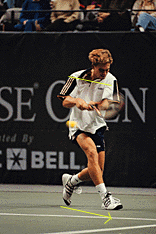 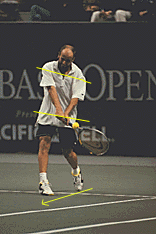 Here we see Gambill
backhand just after contact and Agassi just before contact. Again, you can
see the sharp uncoiling of Gambill's hips and shoulders and the arms close
to the body as he follows through. You can also see Gambill's tendency to
step across to meet the ball rather than forward. Gambill looks like
(and he is) using more arm and muscle power to propel his shot than Agassi,
who has transferred all of his weight forward directly into the path of
the ball. His shoulders have started to uncoil and in a moment, the
kinetic energy of his legs, hips and shoulders is about to be transferred
through the straight lever of his arms into the shot. Here we see Gambill
backhand just after contact and Agassi just before contact. Again, you can
see the sharp uncoiling of Gambill's hips and shoulders and the arms close
to the body as he follows through. You can also see Gambill's tendency to
step across to meet the ball rather than forward. Gambill looks like
(and he is) using more arm and muscle power to propel his shot than Agassi,
who has transferred all of his weight forward directly into the path of
the ball. His shoulders have started to uncoil and in a moment, the
kinetic energy of his legs, hips and shoulders is about to be transferred
through the straight lever of his arms into the shot.
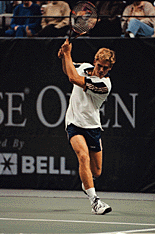 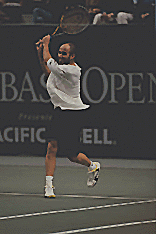 As I look at the
contrasting follow-throughs of Gambill and Agassi, I recall my days of instruction
with Tom Stow (yes, Don Budge's coach too). (See
Tom Stow series on TennisONE.) One of his favorite teaching methods
was about "holding the finish." Tom wanted his students to hold
the finish of their stroke for two seconds or more. Initially, I simply
couldn't do it. I would be twisted, off balance, falling, contorted in all
types of positions, to which Tom would "tut tut" me with something
like, "Jim, I never saw Don Budge look so awkward." Right, Tom.
Stow's idea of balance was that the finish be perfect, the head absolutely
level, the weight precisely on the front foot, and the follow-through along
the line of the shot and well away from the body. And Tom would continue
to tinker way past the point where most other coaches would have been satisfied,
and Tom's tinkering always paid off. With Stow, no detail was too fine. As I look at the
contrasting follow-throughs of Gambill and Agassi, I recall my days of instruction
with Tom Stow (yes, Don Budge's coach too). (See
Tom Stow series on TennisONE.) One of his favorite teaching methods
was about "holding the finish." Tom wanted his students to hold
the finish of their stroke for two seconds or more. Initially, I simply
couldn't do it. I would be twisted, off balance, falling, contorted in all
types of positions, to which Tom would "tut tut" me with something
like, "Jim, I never saw Don Budge look so awkward." Right, Tom.
Stow's idea of balance was that the finish be perfect, the head absolutely
level, the weight precisely on the front foot, and the follow-through along
the line of the shot and well away from the body. And Tom would continue
to tinker way past the point where most other coaches would have been satisfied,
and Tom's tinkering always paid off. With Stow, no detail was too fine.
Well, Gambill is not holding his finish very well here, and if asked
to remain in that position for the count of three he would probably shuffle
into something more comfortable, at which point Tom would exclaim, "Well,
why not finish that way in the first place? And in this vein, Agassi is
just perfect, and continue to study these two pictures until you too can
see what perfect is. The intent, after all, is to hit the ball solidly,
with pace, and with accuracy. And the key to controlling the ball within
those limits is precise balance and a natural use of the body.
While this compares Gambill's backhand unfavorably with Agassi's, this
is nothing to be ashamed about, as Agassi has one of the best backhands
in the game. Make no mistake. Gambill is a world class, a gritty and
determined athlete, who has played with real poise this Spring. But
as one looks over the past and present champions, there has always been
a style and grace consistent with their fortunes. As Gambill moves up in
the tennis world, I can well imagine he will re-engineer his backhand much
more in the mold of Agassi (as well as in the mold of his own open stance
two-handed forehand) and the results will follow.
Send email to the author
We encourage you to email your comments (pro, con, appreciative, whatever)
directly to the author. To send email to Jim McLennan, click
here.
Go To:
Lessons Library
Back To TennisONE Home Page
What's New | Tennis
Lessons | Tennis
in Your Area
Tennis Fitness | Tennis
Products | Sponsors/Advertisers/Consultants
webmaster@tennisone.com
TennisONE© is a trademark of TennisONE© and SportsWeb ONE©.
Copyright© 1995. All rights reserved.
|
|




 Here we see Gambill
backhand just after contact and Agassi just before contact. Again, you can
see the sharp uncoiling of Gambill's hips and shoulders and the arms close
to the body as he follows through. You can also see Gambill's tendency to
step across to meet the ball rather than forward. Gambill looks like
(and he is) using more arm and muscle power to propel his shot than Agassi,
who has transferred all of his weight forward directly into the path of
the ball. His shoulders have started to uncoil and in a moment, the
kinetic energy of his legs, hips and shoulders is about to be transferred
through the straight lever of his arms into the shot.
Here we see Gambill
backhand just after contact and Agassi just before contact. Again, you can
see the sharp uncoiling of Gambill's hips and shoulders and the arms close
to the body as he follows through. You can also see Gambill's tendency to
step across to meet the ball rather than forward. Gambill looks like
(and he is) using more arm and muscle power to propel his shot than Agassi,
who has transferred all of his weight forward directly into the path of
the ball. His shoulders have started to uncoil and in a moment, the
kinetic energy of his legs, hips and shoulders is about to be transferred
through the straight lever of his arms into the shot.
 As I look at the
contrasting follow-throughs of Gambill and Agassi, I recall my days of instruction
with Tom Stow (yes, Don Budge's coach too). (
As I look at the
contrasting follow-throughs of Gambill and Agassi, I recall my days of instruction
with Tom Stow (yes, Don Budge's coach too). (